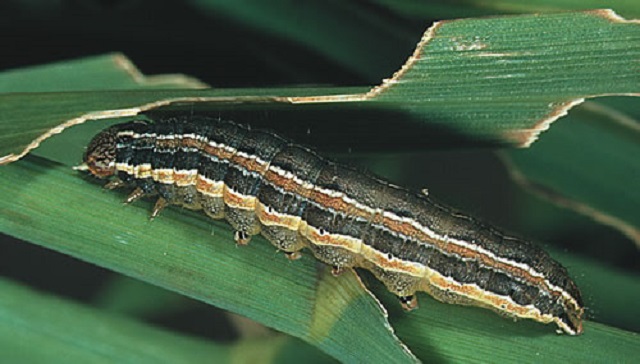Fall armyworm plague threatens prospects for bumper yield

Sifelani Tsiko
A combination of excessive rain and a plague of fall armyworms that has spread to all the country’s provinces have put a damper on prospects for a good harvest in the 2016-2017 cropping season.
Agritex Plant Protection Research Institute head, Dr Godfrey Chikwenhere, told Zimpapers Syndication on Tuesday this week that the fall armyworm outbreak has spread to all the country’s 10 provinces threatening the country’s food security position.
However, he said, the situation was still under control with his department having dispatched teams to all the provinces to try and halt the spread of the outbreak.
“We have so far spent more than $50 000 to contain the outbreak,” said the chief Government entomologist.
“We are on top of the situation and we have distributed contingencies in all the provinces. We are still assessing the situation and we are yet to estimate amount of maize affected and the extent of our appeal to local and international organisation.”
Matabeleland North province was the hardest hit, especially on the irrigated crop which was planted when the rainy season started.
Assessments, Dr Chikwenhere said, were still going on in Mashonaland Central and West provinces.
“The pest is widespread now but the damage levels are still low,” he said. “We are still monitoring the situation. It has been very expensive for farmers to contain the pest. Our teams have moved in swiftly to assist them and despite the outbreak, the crop outlook is still good.”
The current outbreak has been confirmed as that of a different species of armyworm — known as the “fall armyworm” (Spodoptera frugiperda). This is the first report of the fall armyworm in Zimbabwe.
Reports from Government indicate that the pest has affected maize in all the country’s 10 provinces affecting hundreds of hectares of maize and pastures.
The outbreak — reported in all the country’s provinces — has raised fears that hundreds of hectares of maize and pastures could be destroyed if appropriate measures are not taken.
Excessive moisture has also added to the woes threatening the country’s food security position.
This is particularly worrying to a country that endured one of the worst droughts in half a century last year.
The combination of disastrous flooding and excessive rain coupled with latest outbreak of the fall armyworm could cause significant localised disruption in livelihoods and economies in affected areas.
If the damage levels rise, agricultural experts say this could hit the nation hard, causing crop losses, disrupting markets and causing the price of the country’s staple to rise.
Dr Chikwenhere said the management of armyworm requires control in early days following detection to reduce the rate of recurrence.
Control is largely by use of pesticides.
“If left to grow, more chemicals for control will be required and there is the danger of the pest developing resistance to the chemicals,” he said.
“The Government has recommended and distributed Carbaryl 85 WP (a contact pesticide) for the control of the armyworm. As a contact pesticide, the chemical needs to come in contact with the worms to be effective.
“The spraying should be done when the crop is still young (at knee level stage). This is the time that Carbaryl is most effective. To prevent development of insecticide resistance, it is recommended to make alternated application of insecticides in different groups such as pyrethroids, carbamates and organophosphates.”
Heavy rains pouring across the country and the entire Sadc region have brought cheer to a region that endured one of the worst droughts in living memory.
More rain and possible flooding is expected in most parts of the Sadc region in the coming three months, the Sadc Climate Services Centre says.
Regional forecasters say the January to March 2017 outlook is largely going to be for wet conditions with chances of localised, episodic, flash floods.
Despite the huge relief, rains have also dragged some challenges along.
Zimbabwe and other neighbouring countries are facing challenges that include strong winds, floods, waterborne diseases, lots of mosquitoes and malarial incidences, crop pests and diseases.
The prospects for a good harvest in the 2016/2017 farming season look very good so far, but the fall armyworms could spell disaster if urgent interventions are not taken.
Maize is the staple crop in Zimbabwe and the entire southern African region. Cereal deficits affected the entire region last year as a serious drought ravaged southern Africa.
Zimbabwe and its neighbours Zambia and Malawi have reported the outbreak of the armyworm.
In Zambia, the armyworm is reported to have affected 124 000 hectares of maize in that country while in Malawi more than 2 000 hectares of the maize crop was hit by an outbreak of the voracious armyworms.
The voracious pest devours maize and 80 other different types of crops and plants.
Plant experts say in order to combat the spread of the armyworm, the Government requires to strengthen monitoring and surveillance including eliciting the support of Community-Based Armyworm Forecasting (CBAF) units in various parts of the country.
They say early detection is key to sound management of the pest.
“The sudden appearance of armyworms, makes it overwhelming for crop protection authorities that need to react urgently during the short time that is available for control operations,” the UN Food and Agriculture Organisation regional office said in a statement.
“The armyworm needs to be controlled during the early days of its life to reduce the rate of recurrence. The fall armyworm in particular, represents major concern as it is reported that it can have 10 to 12 cycles and hence could continue recurring following the first spray.”
Dr Chikwenhere said the frequency of armyworm outbreaks in recent years is a result of extended drought conditions.
“Major outbreaks of armyworms are commonly preceded by extended drought. The two previous dry seasons that Zimbabwe experienced with particularly severe drought effects of the El-Nino is very likely the reason we have for the current outbreak,” he said.
FAO plant experts say the distribution of outbreaks varies both in time and space and follows the onset of the rains when dryland grass produce new growth and cereal crops (particularly maize) are planted.
“We need to invest more resources in the management of these transboundary pests to keep pest populations below threat levels. This is especially so in the light of climate change which has capacity to influence pest outbreaks and damage impact,” said the FAO southern Africa regional office.
The office further warns that in the event of another dry spell during the season, there is a high possibility of another outbreak of the fall armyworm.
“The economic impact of the fall armyworm outbreak and resultant effects on food security will depend on the levels of infestation and the hectarage affected across the country.
“Comprehensive assessments will have to be undertaken to establish the full impact of the pest on crop production and people’s livelihoods,” the FAO said.
According to a 1997 study by plant and crop experts, infestation during the mid to late whorl stage of maize development caused yield losses of up to between 15 -73 percent when 55 percent of the plants were infested with the fall armyworm.
A staggering $1,1 trillion worth of agricultural products are traded internationally each year, with food accounting for more than 80 percent of the total, according to a 2015 FAO report.
Plant and crop experts say failure to monitor the spread of plant pests and diseases can have disastrous consequences on agricultural production and food security for millions of poor farmers.
They say preventions are the first line of defence against plant pests and diseases.
This, they further say, has also proven the most cost effective ways.
FAO estimates that between 20 and 40 percent of global crop yields are reduced each year due to the damage wrought by plant pests and diseases.
“The fact that the fall armyworm is a new pest to the region poses extra challenges as it will take a bit of time before farmers and other stakeholders understand how to manage it,” said the FAO regional office.
“FAO stands ready to work with governments and farmers to strengthen their capacity in responding and ensuring sustainable management of these transboundary pests.” — Zimpapers Syndication










Comments